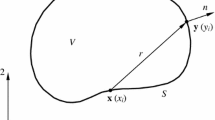Abstract
An adaptive fast multipole boundary element method (FMBEM) for general three-dimensional (3-D) potential problems is presented in this paper. This adaptive FMBEM uses an adaptive tree structure that can balance the multipole to local translations (M2L) and the direct evaluations of the near-field integrals, and thus can reduce the number of the more costly direct evaluations. Furthermore, the coefficients used in the preconditioner for the iterative solver (GMRES) are stored and used repeatedly in the direct evaluations of the near-field contributions. In this way, the computational efficiency of the adaptive FMBEM is improved significantly. The adaptive FMBEM can be applied to both the original FMBEM formulation and the new FMBEM with diagonal translations. Several numerical examples are presented to demonstrate the efficiency and accuracy of the adaptive FMBEM for studying large-scale 3-D potential problems. The adaptive FMBEM is found to be about 50% faster than the non-adaptive version of the new FMBEM in solving the model (with 558,000 elements) for porous materials studied in this paper. The computational efficiencies and accuracies of the FMBEM as compared with the finite element method (FEM) are also studied using a heat-sink model. It is found that the adaptive FMBEM is especially advantageous in modeling problems with complicated domains for which free meshes with much more finite elements would be needed with the FEM.
Similar content being viewed by others
References
Saad Y, Schultz M (1986) A generalized minimal residual algorithm for solving nonsymmetric linear system. SIAM J Sci Stat Comput 7:856–869
Rokhlin V (1985) Rapid solution of integral equations of classical potential theory. J Comput Phys 60:187–207
Greengard LF, Rokhlin V (1987) A fast algorithm for particle simulations. J Comput Phys 73:325–348
Greengard LF (1988) The rapid evaluation of potential fields in particle systems. The MIT Press, Cambridge, MA
Nishimura N, Liu YJ (2004) Thermal analysis of carbon-nanotube composites using a rigid-line inclusion model by the boundary integral equation method. Comput Mech 35:1–10
Liu YJ, Nishimura N (2005) The fast multipole boundary element method for potential problems – a tutorial. Eng Anal Bound Elem (in press)
Nishimura N (2002) Fast multipole accelerated boundary integral equation methods. Appl Mech Rev 55:299–324
Yoshida K, Nishimura N, Kobayashi S (2001) Application of new fast multipole boundary integral equation method to crack problems in 3D. Eng Anal Bound Elem 25:239–247
Yoshida K, Nishimura N, Kobayashi S (2001) Application of fast multipole Galerkin boundary integral equation method to crack problems in 3D. Int J Num Meth Eng 50:525–547
Yoshida K, Nishimura N, Kobayashi S (2001) Application of new fast multipole boundary integral equation method to elastostatic crack problems in three dimensions. JSCE J Struct Eng 47A:169–179
Nishimura N, Yoshida K, Kobayashi S (1999) A fast multipole boundary integral equation method for crack problems in 3D. Eng Anal Bound Elem 23:97–105
Chew WC et al (2003) Fast integral equation solvers in computational electromagnetics of complex structures. Eng Anal Bound Elem 27:803–823
Liu YJ, Nishimura N, Otani Y (2005) Large-scale modeling of carbon-nanotube composites by the boundary element method based on a rigid-inclusion model. Comput Mater Sci 34:173–187
Liu YJ, Nishimura N, Otani Y et al (2005) A fast boundary element method for the analysis of fiber-reinforced composites based on a rigid-inclusion model. J Appl Mech 72:115–128
Beatson R, Greengard L (1996). A short course on fast multipole methods. In: Ainsworth M et al (eds). Wavelets, multilevel methods and elliptic PDEs. Oxford University Press, Oxford, pp 1–37
White CA, Head-Gordon M (1996) Rotating around the quartic angular momentum barrier in fast multipole method calculations. J Chem Phys 105:5061–5067
Greengard L, Rokhlin V (1997) A new version of the fast multipole method for the Laplace equation in three dimensions. Acta Num 6:229–269
Wang H, Yao ZH (2005) A new fast multipole boundary element method for large scale analysis of mechanical properties in 3D particle-reinforced composites. Comput Model Eng Sci 7:85
Cheng H, Greengard L, Rokhlin V (1999) A fast adaptive multipole algorithm in three dimensions. J Comput Phys 155:468–498
Brebbia CA, Dominguez J (1989) Boundary elements – an introductory course. McGraw-Hill, New York
Banerjee PK (1994) The boundary element methods in engineering. McGraw-Hill, New York
Yoshida K (2001) Applications of fast multipole method to boundary integral equation method. PhD Thesis, Department of Global Environment Engineering, Kyoto University
Nishida N, Hayami K (1997) Application of the fast multipole method to the 3-D BEM analysis of electron guns. In: Boundary elements XIX, Proceedings of 19th International Conference on the boundary element method. Computational Mechanics Publications
Moaveni S (2002) Finite element analysis – theory and application with ANSYS. Prentice-Hall, Englewood Cliffs, NJ
Zhang J, Tanaka M, Endo M (2005) The hybrid boundary node method accelerated by fast multipole expansion technique for 3D potential problems. Int J Num Meth Eng 63:660–680
Liu YJ, Nishimura N, Yao ZH (2005) A fast multipole accelerated method of fundamental solutions for potential problems. Eng Anal Bound Elem 29:1016–1024
Author information
Authors and Affiliations
Corresponding author
Rights and permissions
About this article
Cite this article
Shen, L., Liu, Y.J. An Adaptive Fast Multipole Boundary Element Method for Three-dimensional Potential Problems. Comput Mech 39, 681–691 (2007). https://doi.org/10.1007/s00466-006-0046-9
Received:
Accepted:
Published:
Issue Date:
DOI: https://doi.org/10.1007/s00466-006-0046-9




